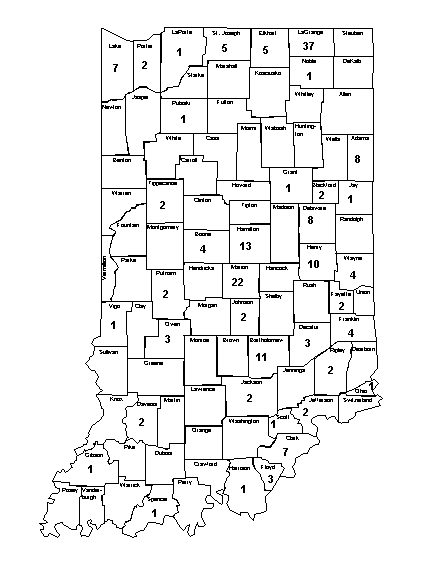
In 1994 the Indiana State Department of Health set goals for the elimination of measles, rubella, polio, diphtheria, and tetanus in persons under the age of fifteen, and invasive Haemophilus influenzae type b disease in children under the age of five. For each of these diseases, in at least one year since 1994, the target of zero cases has been achieved. Appendix F shows the number of cases for selected childhood vaccine-preventable diseases from 1949 through 1998. In 1998, the target of zero was reached for rubella, diphtheria, and tetanus under the age of fifteen years. Indiana established a goal of no more than ten cases of mumps in 1998, which was also attained. A specific goal for pertussis has not been established. The following narrative describes childhood vaccine-preventable disease morbidity for 1998.
Cases =185
One hundred-eighty-five (185) cases of pertussis occurred in Indiana during 1998, the most cases reported since 1985. An outbreak involving 37 persons, occurring in a mostly unvaccinated population in LaGrange County, accounted for 20% of the cases in 1998. The 1998 case rate for LaGrange County was 125 per 100,000 as compared with the state case rate of 3.34 per 100,000. Thirty-eight counties reported at least one case of pertussis during the year (Figure 1), with five counties accounting for over 50% of the cases.
Figure 1. Pertussis Cases by County - 1998

Of the 79 cases in infants less than a year old, 52 (65.8%) were hospitalized. This compares with only 5 of 106 (4.7%) cases over one year of age being hospitalized. A two-week old infant died from complications due to pertussis infection in 1998. Forty cases (21.6%) were culture confirmed with another 13 (7.0%) being positive by PCR analysis. Seventy-nine (42.7%) of the cases were less than one year of age and 29 (15.7%) cases were 20 years or older (Figure 2; complete age breakdown).
Figure 2.
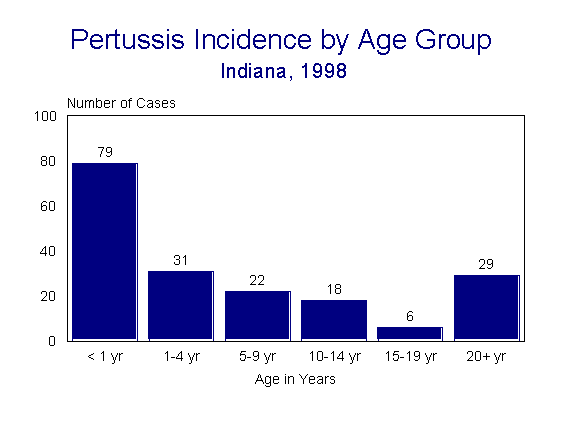
Table 1 depicts the vaccination status of cases less than 7 years of age.
Table 1.
Age |
Minimum |
Number Vaccinated with Minimum Doses/ Total |
Percent |
| 3-4 mo | 1+ |
12 / 18 |
66.7% |
| 5-6 mo | 2+ |
3 / 7 |
42.9% |
| 7-18 mo | 3+ |
4 / 11 |
36.4% |
| 19 mo-4yrs | 4+ |
9 / 24 |
37.5% |
| 5-6 yrs | 4+ |
5 / 13 |
38.6% |
| Total | 33 / 73 |
45.2% |
Pertussis incidence (Figure 3), has shown a gradual increase during the 1990s. The five-year mean for the last five years was 118 (1994-98) compared to 110 for the preceding five years (1989-93). Incomplete vaccine coverage is only one reason that cases of pertussis continue in unacceptable numbers. Babies may be infected by older children and adults, whose immunity to pertussis has waned. Currently, pertussis vaccine is only available for children less than seven years of age. The research community continues to work on development of a vaccine that is safe and effective for those seven years and older, which will aid in the reduction of pertussis incidence in older age groups. Figure 4 shows pertussis cases by gender.
Figure 3.
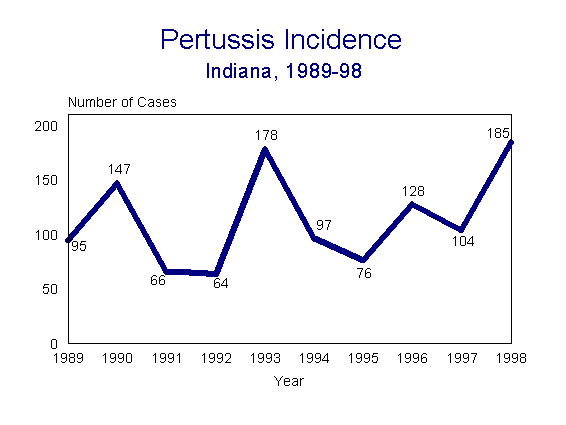
Figure 4.

Haemophilus influenzae type b (invasive)
Cases = 6 (two cases less than five years of age)
Six cases of invasive Haemophilus influenzae type b (Hib) were reported in 1998, two of which were in children less than five years of age. The remaining four cases were all 18 years of age or older. Prior to the introduction of Hib vaccine, Haemophilus influenzae type b disease was the leading cause of bacterial meningitis in children. Since the introduction of Hib vaccine in the late 1980s, the incidence of invasive Hib disease has decreased dramatically in children. The mean number of Hib cases the past five years is 1.8 per year (Figure 6). In 1998, 13 cases of invasive Haemophilus influenzae disease were reported in children less than five years of age, all of which were serotyped. Fifty-one cases of invasive Haemophilus influenzae disease were reported in all age groups with 41 (80.3%) being serotyped. Efforts continue to ensure that all invasive Haemophilus influenzae isolates be serotyped to determine if type b illness is present.
Figure 6.
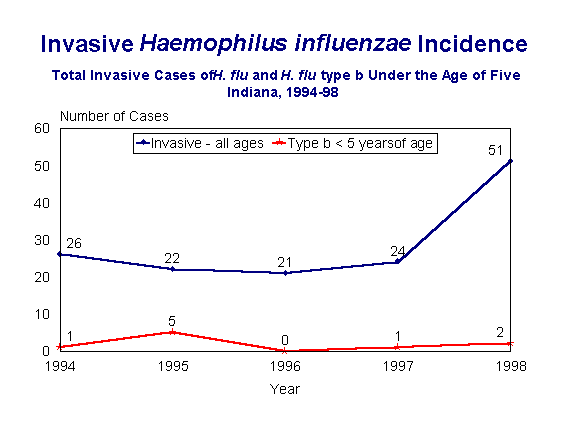
Cases = 7
Mumps incidence remains at record low levels in the state with only seven cases being confirmed either by laboratory analysis (4) or meeting the case definition (3). Of the seven cases, three had one dose of mumps vaccine, three had zero doses, and the vaccine history was unknown for one case. Figure 8 shows cases by county location. Of the 7 cases, one was less than 5 years of age, four were between 5 and 19 years old, and two were over 20 years of age. Five of the cases were male. While these seven cases were the lowest total since 1994 (Figure 7), because of the small number of cases reported yearly, this variation should be interpreted with caution.
Figure 7.
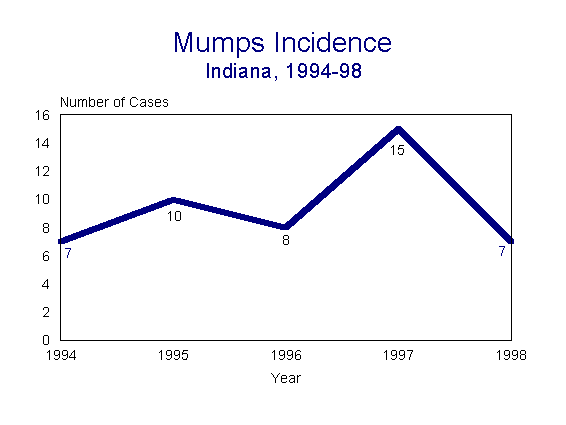
Figure 8. Mumps Cases by County - 1998
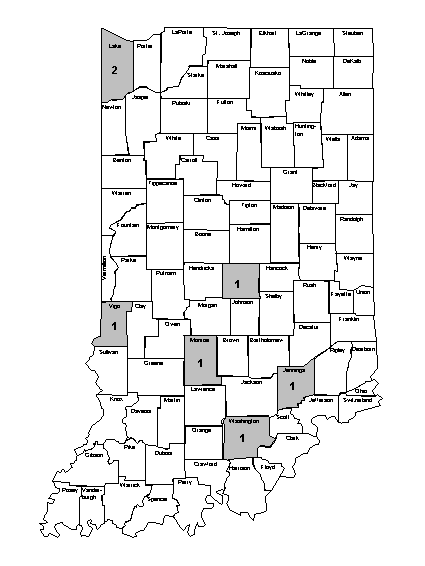
Cases = 3
Three cases of measles, all unimmunized and in the same family, occurred in 1998. The index case, a 15 year-old female living in Marshall County, was exposed on a trip to Zimbabwe in March. She returned home in April, infected with measles virus, which was later confirmed by a positive IgM antibody test. Two younger siblings, an eight year old sister and twelve year old brother were both exposed and developed rash about two weeks after the index case developed symptoms. Blood was drawn on the two siblings and both were IgM positive. Although all three cases attended public schools in St. Joseph County, no other cases occurred either in the school or community. Limited transmission from this measles case and other international importations demonstrates the success of vaccination efforts in Indiana and the United States. Measles vaccine coverage rates for children 19-35 months of age was 87% in Indiana and 91% in the U.S. in 1996 according to CDC National Immunization Surveys. For Indiana children in the sixth grade and above, two-dose coverage has been above 98% since the requirement was implemented in 1991. Measles cases have continually declined (Figure 5), since the two-dose requirement and other vaccination efforts aimed at preschool children were implemented in the early 1990s. Since 1990, there were 3 years in which no cases were reported (1995 - 1997) and 2 years in which only 1 case was reported (1993-1994).
Figure 5.
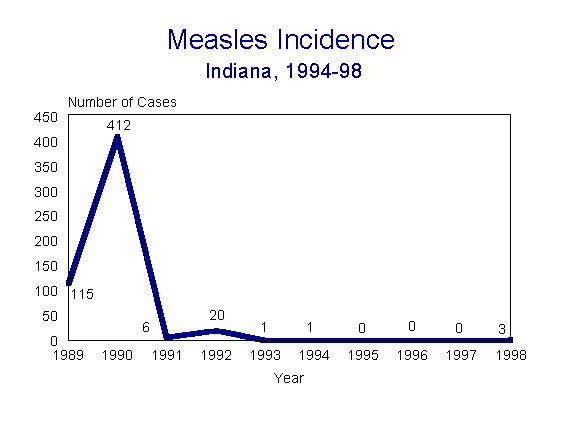
Cases = 0
The last case of rubella in Indiana was confirmed in 1993.
Cases = 1 case of vaccine associated paralytic poliomyelitis
A case consistent with paralytic poliomyelitis occurred in a two-month old male in 1998. The child had received a dose of Oral Polio Vaccine on December 30, 1997 and on January 22, 1998 the parents reported limpness in the right lower extremity. After exhaustive medical examinations by numerous doctors and review by a Centers for Disease Control and Prevention panel of experts, the child's diagnosis was confirmed as vaccine associated paralytic polio. This is the first such case occurring in Indiana since 1991.
Cases = 1
One case of tetanus occurred in a 85 year old female. The patient reported never having received tetanus toxoid prior to her injury, which occurred while working in her yard. The patient, who recovered, was hospitalized for 26 days. This was the first case of tetanus in any age group confirmed in Indiana since 1994.
Cases = 0
The last case of diphtheria to occur in Indiana was in 1996. The last case previous to 1996 occurred in 1970.
[an error occurred while processing this directive]